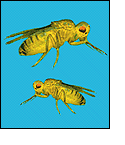Return to Online
Education Kit
|
 |
 |
 Previous Event | Next Event Previous Event | Next Event 
2000: Drosophila and Arabidopsis genomes sequenced

Drosophila melanogaster (fruit fly)has been a primary tool for geneticists since the early part of the twentieth century. The sequencing of its genome is the result of a collaborative effort between the Drosophila Genome Project Group, led by Gerald Fink at the University of California, Berkeley and researchers from Celera Genomics Corporation led by Craig Venter. The Drosophila genome is estimated to have approximately 13,600 genes as compared to 20,000—25,000 genes in humans. The popularity of Drosophila as an experimental organism ensures that its genome sequence will be a valuable resource for research in genetics and medicine. Many genes of Drosophila have been conserved through evolution and have human counterparts. This means that scientists can perform experiments using flies and apply their findings to human biology.
Arabidopsis thaliana is the first plant to have its genome sequenced. This plant from the mustard family has become the plant biologists’ equivalent of the laboratory mouse. Its genome was completed by the collective efforts of an international group of researchers called the Arabidopsis Genome Initiative. The Arabidopsis genome has an estimated 25,000 genes—apparently even more than humans. Although not a crop plant, Arabidopsis was chosen as a model organism because its genome is small and it has relatively little of the noncoding, so-called junk, DNA. It does, however, share very similar biochemistry to crop plants such as rice or barely. The study of its sequence is expected to have widespread applications for agriculture and medicine.
More Information
Reference:
M. Adams, S.E. Celniker, R.A. Holt, C.A. Evans, J.D. Gocayne et. al. The genome sequence of Drosophila melanogaster. Science, 287:2185-2195. 2000.
[Full Text] 
Analysis of the genome sequence of the flowering plant Arabidopsis thaliana, The Arabidopsis Genome Initiative. Nature, 408: 796-815. 2000. [PubMed]
To view the PDF on this page, you will need Adobe Reader. 
 Previous Event | Next Event Previous Event | Next Event 
Last Reviewed: April 10, 2008
|

